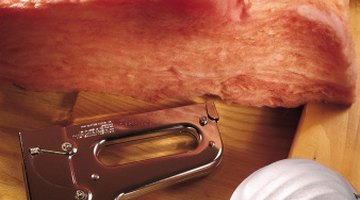What Makes Fiberglass Insulation a Good Insulator?
Fiberglass insulation starts out as sand, silica, recycled glass cullet, soda ash and other materials cooked in an oven reaching temperatures up to 3,000 degrees Fahrenheit or more.

As it cooks, it takes on the appearance of red-hot molten lava; when it reaches the right consistency, the mixture is spun like cotton candy and then laid down in a mat for batt insulation. Sprayed with binders and oils and cooked in an oven again, what emerges becomes fiberglass roll or batt insulation.
Spinning the Glass
When the glass reaches the right consistency in the huge oven, it is fed into a hopper that spins the glass into fibrous strands. As the strands are created, air pockets get trapped between the strands and it's the air pockets in the space between the strands that become the insulator in fiberglass insulation.
Limiting Air Movement
Fiberglass insulation works by limiting air movement in the space that it occupies. Warmer air naturally moves towards a cooler space. The air trapped between the fibrous strands in fiberglass doesn't move and creates still air, effectively eliminating convection and conduction and insulating the space. During the winter months, heat travels to the colder areas and during the summer, cold air must be kept inside the house. The fiberglass insulation effectively limits this air movement.
Heating and Cooling
The U.S. Department of Energy advises that heating and cooling account for 50 to 70 percent of a home's utility expenses. It also states that "Inadequate insulation and air leakage are leading causes of energy waste in most homes." During winter or summer months, to make living spaces comfortable, it becomes necessary to heat or cool the air in that space. Homes properly insulated with fiberglass insulation form an envelope around the home, or an insulated barrier that reduces or eliminates convection and heat or cold conduction, keeping the "conditioned" air inside.
Fiberglass Insulation is Not a Sealer
While fiberglass effectively reduces the movement of air, leaks in a home will allow the warm-cold air exchange to take place. Don't mistake fiberglass insulation with air sealing. Ensure that all openings, no matter the size, are sealed against air exchange. This includes sealing all cracks between the sill of a house and its foundation, and sealing around windows and doors properly. The U.S. Department of Energy offers a special weatherization program for those who qualify to help reduce utility bills.
References
Writer Bio
As a native Californian, artist, journalist and published author, Laurie Brenner began writing professionally in 1975. She has written for newspapers, magazines, online publications and sites. Brenner graduated from San Diego's Coleman College.
Photo Credits
- Comstock/Comstock/Getty Images
- Comstock/Comstock/Getty Images
More Articles


